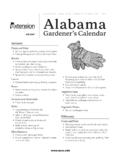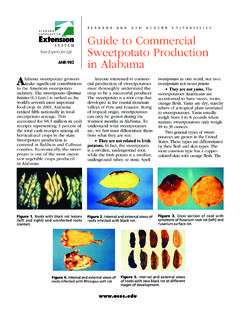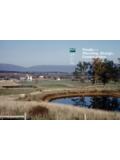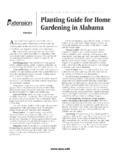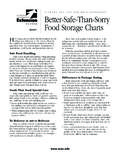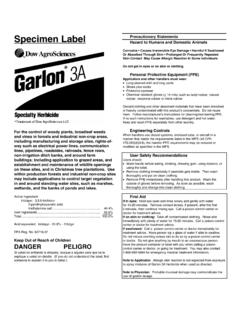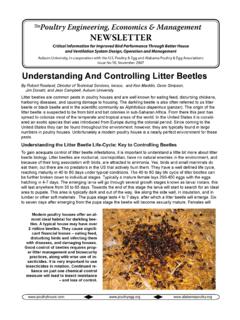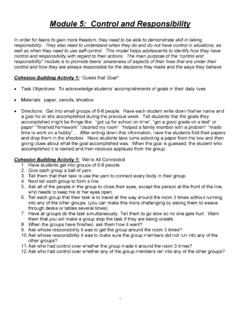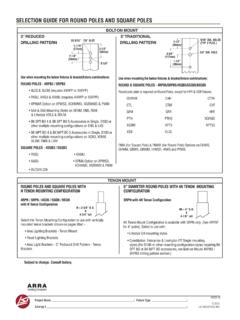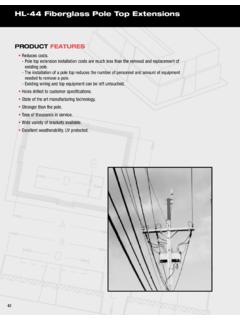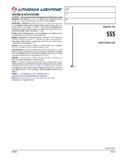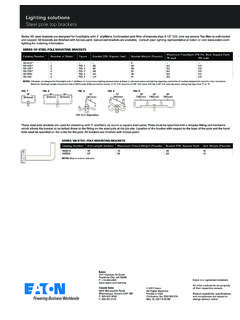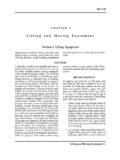Transcription of Haemonchus contortus (Barber Pole Worm) Infestation in Goats
1 ALABAMA A&M AND AUBURN UNIVERSITIES. Haemonchus contortus (Barber Your Experts for Life pole Worm) Infestation in Goats UNP-78. Gastrointestinal nematodes, commonly Morphology known as worms, present the greatest danger to the goat industry in the South- Adults (20-30 mm); Eggs are thin-shelled, 24 cell eastern region of the United States. Hae- monchus contortus , commonly referred to Adult H. contortus live in the abomasum as the barber pole worm, is a clinical (true stomach) of Goats . problem for Goats . Anemia, low packed cell volume (PCV), diarrhea, dehydration, peripheral, and internal fluid accumulation are common signs of barber pole worm Infestation . Infested Goats have lower growth rates, markedly reduced reproduc- tive performance, and have higher rates of illness and death. Consequently, H. contortus may account for greatly reduced profits in a goat operation. In the Southeast region, there are a number of factors that contribute to barber pole worm Infestation in Goats : Environment with high temperatures, humidity, and rainfall Genetic make-up of Goats makes them highly susceptible Adult H.
2 contortus recovered after necropsy. Resistance to anthelmintics as a result of excessive usage Life Cycle Frequent anthelmintic treatments per year without a positive fecal sample Goats are born without H. contortus ; however, exam they become infested with the worm when they Many goat producers overstock their start grazing. The L3, or infecting larvae, are eaten pastures and maintain as many as 40 by the Goats during grazing. The L3 larvae then Goats per acre burrow into the internal layer of the goat's Few anthelmintics drugs are approved abomasums (true stomach) where they develop to by the Food and Drug Administration a L4, or pre adult larvae. The L4 molts into L5, the for goat use. adult form. About Barber pole Worms Adult male and female worms live in the abo- masum of Goats , where they feed on blood. The Haemonchus contortus is cylindrically worms mate and produce eggs. Adult females shaped, tapered at both ends, and has a deposit from 5,000 to 10,000 eggs per day, which complete digestive system.
3 This worm is a are passed through goat feces to the pasture. Eggs worldwide threat, but is more prevalent in are hatched either in soil or water. When the soil is sub-temperate and temperate regions warm and moist, eggs will hatch into L1 larvae under warm and wet conditions, such as in (first stage juveniles). The L1 larvae then develop the Southeastern United States. through stages L2 and L3. Signs of the barber pole worm Infestation in Goats : Large numbers of juvenile parasite worm (L3) may Diarrhea accumulate on heavily grazed Dehydration pastures. Unthrift appearance, rough hair coat, depresssed, low energy, lethargic, and uncoordinated Damage Caused by Barber Significantly reduced growth and reproductive performance pole Worm Fluid accumulation in sub-mandibular tissues (bottle jaw), abdomen, thoracic cavity, and gut wall After a goat has ingested Blood loss, white mucous membranes, anemia/PCV. L3 larvae, the worm will burrow into the mucosal (internal layer) of the stom- ach, nourishing on the red blood cells of the Goats , which can be life-threatening to the goat.
4 An infected goat can bleed to death within hours. Signs of peripheral and sub- Extreme dehydration, mandibular (bottle jaw) edema near death Note: Larva is a juvenile form, the newly hatched, earliest stage worm that undergoes metamorpho- sis, differing markedly in form and appearance from the adult. Anthelmintics are widely used to battle worms and worm eggs. Blood loss, anemia, Stomach after necropsy. white musous membranes Controlling Barber pole Worm Scientists have been researching ways to manage this para- sitic worm and minimize cost production in herds. Management practices must be based upon breaking or interrupting the life cycle of the worm by: Use of chemical anthelmintics commercially available Improved herd and pasture management practices Use of plants with anthelmintic properties Goats are browsers, introduce shrubs Use of Commercial Anthelmintics and forbes in your pasture. Anthelmintics (chemicals/drugs) are widely used to battle barber pole worms.
5 However, only two anthelmin-tics are 2 Alabama Cooperative Extension System approved by the Food and Table 1: Anthelmintics (Chemicals or drugs for deworming) with Drug Administration (FDA) to a direct effect on the worm or worm eggs. treat Goats : Morantel tartrate and Fenbendazole. Producers Anthelmintics Brand FDA Dosage Route Withdrawn have reported that the drugs (Dewormer) Name Approval Meat Milk have shown little effectiveness in the control of the barber Benzimidazoles Panacur/ App'd Oral 14d 4d pole parasite in goat herds Fenbendazole Safeguard because of the worm's resis- tance. Cholinergic Agonist Rumatel App'd Oral 30d 0d Morantel tartrate Use of others anthelmintics is called extra-label use be- Note: Consult your veterinarian as part of your parasite control cause they are not approved program to get information about the appropriate use, dose, by the FDA for use on Goats route, duration, possible adverse effects, and withdrawal periods unless used under veterinarian for various extra-label anthelmintics before administration in guidance.
6 Your herd. Improved Herd, Pasture and Management Practices Here are some ways to control barber pole worms: Feeding Practices Keep stocking rates low. Provide clean water and minerals. Use gravel or concrete in the feedlot area to break the worm life cycle and to prevent re- Infestation . Dry lot to interrupt worm life cycle. Provide high-quality hay for Goats raised in areas where forage is not available year-round or when the pasture conditions are poor. Hay should be kept off of the ground to avoid contamination by feces. Pasture Maintenance Incorporate browse plant species when possible. Goats love to browse and prefer shrubs and forages to grass. If Goats consume forages at least 6 inches tall, Infestation from barber pole worms is reduced. Try a mixed species grazing program using cattle and Goats . When possible, use the pasture for hay cutting after grazing. This will help to break the worm life cycle and prevent re- Infestation . Direct sunlight during the summer months or during freezes in the winter will also help decrease the population of larvae that remain in the soil.
7 When possible, alternate the pasture with a short cycle crop, such as culture alfalfa. This management practice will help to break the worm's life cycle, and decrease larvae popula- tion in the pasture and prevent re- Infestation . Use clean feeders and continue to practice good hygiene in the pens and pasture. Doe Treatment Provide good nutritional management. Well-nourished animals are better able to respond to H. contortus Infestation . Does with good nutrition at late pregnancy have an increased im- mune response to parasites. Deworm the doe soon after she has kidded. The pregnancy hormone progesterone and the lactate hormone prolactin have been shown to reduce the ability of does to fight worm infes- tation. Progesterone suppresses the doe's immune system. Does that are lactating and raising kids are more susceptible to worms. Monitor the herd closely from kidding to weaning. Goat genetics are an important component that will determine an animal's ability to resist H.
8 contortus Infestation . Resistance can be measured by fecal egg counts (FEC). The resistance to worm Infestation is heritable. The doe's ability to withstand Infestation is defined as Breed Options for Meat Goat Production in Alabama 3. resilience and is measured treated. This practice will and resilience, which seem to by blood hematocrit or prevent the overuse of be inherited traits in Goats . packed cell volume (PCV). anthelmintics and conse- Resilience is less heritable quently minimize chances of Use of Plants with than resistance. parasite resistance to Anthelmintic Properties anthelmintics. The test has an FAMACHA System as a effectiveness of 90 percent Researchers are exploring Management Tool to Con- compared to the 20-30 per- the use of plants to control trol Barber pole Worms in cent effectiveness of overused barber pole worm. Forages, Goats anthelmintics. such as clover, vetches, chicory, and sericea lespe- The FAMACHA system was Goat producers should deza, contain condensed developed by South African check 10 percent of the total tannins.
9 Condensed tannins scientists and veterinarians. It animals in the herd as fre- reduce the number of stomach is a low-cost tool that can quently as every other week worms and egg production. greatly influence management using the FAMACHA chart. A Feeding sericea lespedeza hay practices in Goats . The fecal exam should accompany to Goats can reduce fecal eggs FAMACHA system monitors FAMACHA examination. counts by 80 percent and clinical anemia (reduction of create a higher packed cell red blood cells, packed cell FAMACHA also provides volume. volume) by examining the producers with a tool for color of the goat's lower genetic selection. Using Note: eyelids and comparing it to a FAMACHA, producers can Larva is a juvenile form, the color-coded chart. Variation in identify animals that are more newly hatched, or earliest eyelid color from pale to red susceptible to hosting the stage worm that undergoes indicates the degree of ane- worm and can cull these Goats metamorphosis, differing mia.
10 Based on this chart, only from the herd. In turn, pro- markedly in form and appear- Goats with anemia should be ducers will be able to identify ance from the adult. Anthel- animals with high resistance mintics are widely used to battle worms and worm eggs. References Browning, R. Jr., et al. (August 2006). Evaluation of three meat goat breeds for doe fitness and reproductive performance in the southeastern United States. IN 8th World Congress on Genetics Applied to Livestock Production, Belo Horizonte, MG, Brazil. Fleming, S. A., et al. (2006). Consensus Statement on: Anthelmintic resistance of gastrointestinal parasites in small ruminants. Journal of Veterinary Internal Medicine, 20, 435 444. Kaplan, R. M., et al. (2004). Validation of the FAMACHA eye color chart for detecting clinical anemia in sheep and Goats on farms in the southern United States. Veterinary Parasitology, 123, 105-120. Shaik, S. A., et al. (2006). Sericea lespedeza hay as a natural deworming agent against gastrointestinal nematode infection in Goats .
